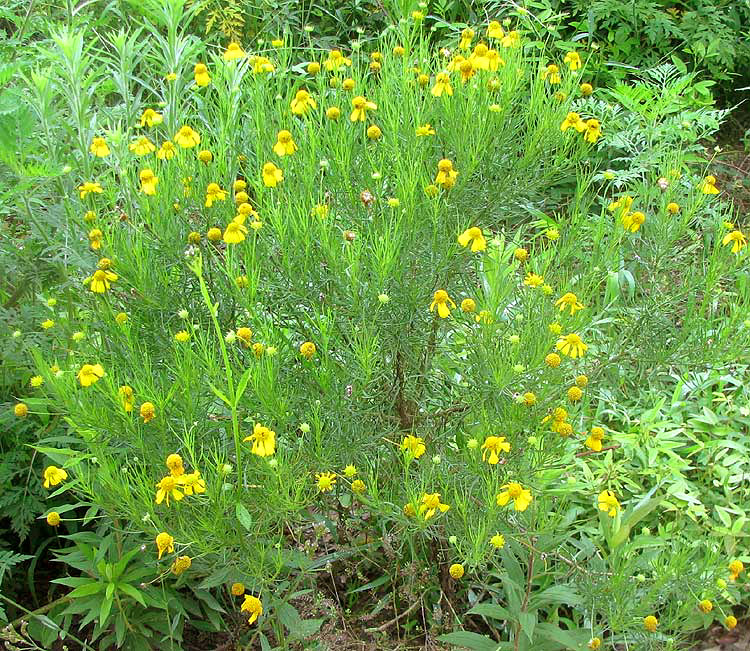Excerpts from Jim Conrad's
Naturalist Newsletter

from the the July 22, 2012 Newsletter issued from the woods of the Loess Hill Region a few miles east of Natchez, Mississippi, USA
BITTER SNEEZEWEED
Above you see a knee-high roadside and pasture weed that these days is common, easy-to-identify and interesting. It's the Bitter Sneezeweed, HELENIUM AMARUM. Six sneezeweed species are listed for Mississippi. Yellow Sneezeweed is distinguished from the others by its very slender leaf parts and the yellow, spherical "eye" of its composite heads. Most other species have dark "eyes."
Back on the farm in Kentucky we knew all about Bitter Sneezeweed and made sure it didn't grow in the pasture because if the cow ate it her milk would be bitter. All parts of the plant contain the glycoside gudaldin and can cause toxic symptoms in grazing animals, especially horses and mules. Symptoms include weakness, diarrhea, vomiting, bloating, staggering, salivation, labored respiration, rapid and irregular pulse, spasms, convulsions and death. The seeds have poisoned humans by contaminating flour.
Sneezeweed doesn't cause hay fever. Its pollen is too heavy and gummy to ride air currents and get into our noses. The Sneezeweed name arose back in the days when people were likely to put snuff up their noses in order to provoke sneezing and "clearing of the head." Apparently if you poke Sneezeweed leaves up your nose they'll serve the same purpose. However, though I find the crushed leaves' strong odor almost pleasant, with their toxic chemicals I'd hesitate to stuff them up my nose.
Bitter Sneezeweed is native to the US Southeast and northern Mexico, plus it's been introduced in other states such as Massachusetts and California.
from the July 22, 2012 Newsletter issued from the woods of the Loess Hill Region a few miles south of Natchez, Mississippi; elevation ~200ft (~60m), ~N31.42°, ~W91.41°; USA
SNEEZEWEED ALONG US 61
Wednesday night a limb fell from a large Pecan tree near where I sleep in the forest. It knocked out my electricity and sent a voltage surge right through my surge protector, and knocked out my computer's modem, even though I had turned off the computer. Consequently on Thursday I had to make one of my infrequent runs into town, for a modem at Wal-Mart.
Right next to the pavement along US 61 there dwells a thin line of yellow-flowered weeds about a foot tall, and they accompany the pavement's edge for miles and miles. The same plant has been blooming for a couple of months in the middles of the more seldom-used gravel roads on the plantation. It's a tough little organism producing surprisingly pretty blossoms and fragile-looking threadlike leaves. This is Sneeze Weed, or Bitterweed (HELENIUM AMARUM) in the Sunflower family.
It's worth thinking about how Sneeze Weeds form their thin line next to the pavement. Their zone of occupation is only about a foot wide in most places. Clearly they cannot live right next to the pavement, yet neither do they survive farther away, where roadside grass appears. They have evolved for a very specific sandy, dry habitat and do not range far beyond it. Their long taproot helps them survive droughts in the sand, and frequent mowing and grazing. They are native to the US Southeast, Texas and Mexico, but in recent years have spread to northern states along gravelly highways and into sandy pastures.